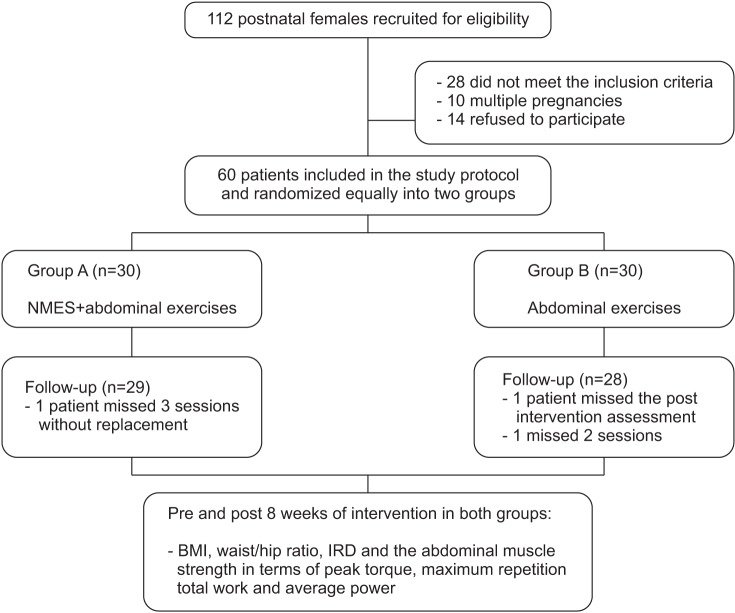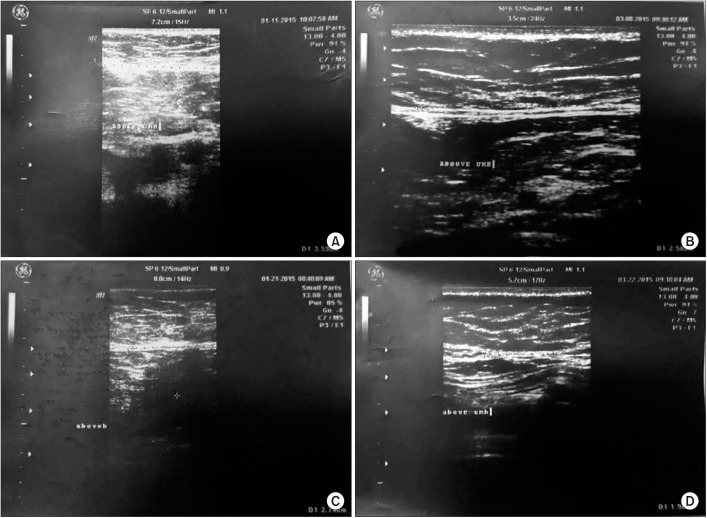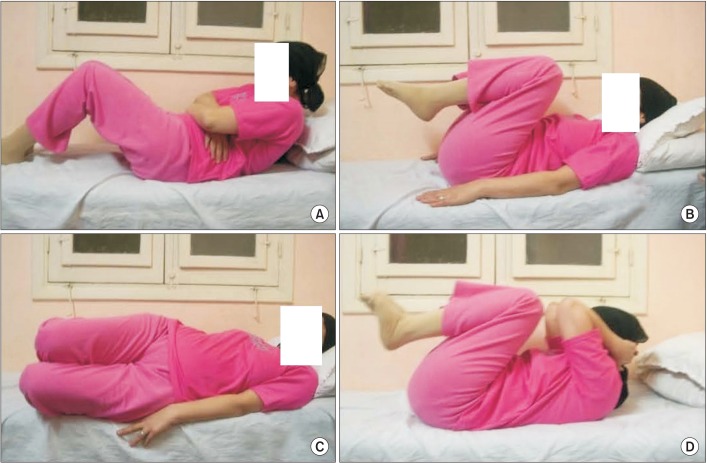Ann Rehabil Med.
2017 Jun;41(3):465-474. 10.5535/arm.2017.41.3.465.
Neuromuscular Electrical Stimulation and Strength Recovery of Postnatal Diastasis Recti Abdominis Muscles
- Affiliations
-
- 1Department of Physiotherapy for Obstetrics and Gynecology, Faculty of Physical Therapy, Cairo University, Giza, Egypt. dshewitta@ahlia.edu.bh
- 2Department of Physiotherapy, College of Medical & Health Sciences, Ahlia University, Manama, Bahrain.
- KMID: 2389463
- DOI: http://doi.org/10.5535/arm.2017.41.3.465
Abstract
OBJECTIVE
To assess the effect of neuromuscular electrical stimulation (NMES) on the recovery of abdominal muscle strength in postnatal women with diastasis of recti abdominis muscles (DRAM).
METHODS
Sixty women, 2 months postnatal, participated in this study. They were divided randomly into two equal groups. Group A received NMES in addition to abdominal exercises; group B received only abdominal exercises. The intervention in both groups was for three times per week for 8 weeks. The outcome measures were body mass index (BMI), waist/hip ratio, inter recti distance (IRD), and abdominal muscle strength in terms of peak torque, maximum repetition total work, and average power.
RESULTS
Both groups showed highly significant (p<0.05) improvement in all outcomes. Further, intergroup comparisons showed significant improvement (p<0.05) in all parameters in favor of group A, except for the BMI.
CONCLUSION
NMES helps reduce DRAM in postnatal women; if combined with abdominal exercises, it can augment the effects.
Keyword
MeSH Terms
Figure
Reference
-
1. Venes D. Taber's cyclopedic medical dictionary. 20th ed. Philadelphia: F. A. Davis;2005.2. Spitznagle TM, Leong FC, Van Dillen LR. Prevalence of diastasis recti abdominis in a urogynecological patient population. Int Urogynecol J Pelvic Floor Dysfunct. 2007; 18:321–328. PMID: 16868659.
Article3. Gilleard WL, Brown JM. Structure and function of the abdominal muscles in primigravid subjects during pregnancy and the immediate postbirth period. Phys Ther. 1996; 76:750–762. PMID: 8677279.
Article4. Artal R, O'Toole M. Guidelines of the American College of Obstetricians and Gynecologists for exercise during pregnancy and the postpartum period. Br J Sports Med. 2003; 37:6–12. discussion 12. PMID: 12547738.
Article5. Fernandes da Mota PG, Pascoal AG, Carita AI, Bo K. Prevalence and risk factors of diastasis recti abdominis from late pregnancy to 6 months postpartum, and relationship with lumbo-pelvic pain. Man Ther. 2015; 20:200–205. PMID: 25282439.6. Sperstad JB, Tennfjord MK, Hilde G, Ellström-Engh M, Bo K. Diastasis recti abdominis during pregnancy and 12 months after childbirth: prevalence, risk factors and report of lumbopelvic pain. Br J Sports Med. 2016; 50:1092–1096. PMID: 27324871.7. Candido G, Lo T, Janssen PA. Risk factors for diastasis of the recti abdominis. J Assoc Chart Physiother Womens Health. 2005; (97):49–54.8. Turan V, Colluoglu C, Turkyilmaz E, Korucuoglu U. Prevalence of diastasis recti abdominis in the population of young multiparous adults in Turkey. Ginekol Pol. 2011; 82:817–821. PMID: 22384613.9. Mesquita LA, Machado AV, Andrade AV. Physiotherapy for reduction of diastasis of the recti abdominis muscles in the postpartum period. Rev Brasil Ginecol Obstet. 1999; 21:267–272.10. Rett MT, Braga MD, Bernardes NO, Andrade SC. Prevalence of diastasis of the rectus abdominis muscles immediately postpartum: comparison between primiparae and multiparae. Braz J Phys Ther. 2009; 13:275–280.11. Lee DG, Lee LJ, McLaughlin L. Stability, continence and breathing: the role of fascia following pregnancy and delivery. J Bodyw Mov Ther. 2008; 12:333–348. PMID: 19083692.
Article12. Parker MA, Millar AL, Dugan SA. Diastasis rectus abdominis and Lumbo-pelvic pain and dysfunction: are they related? J Womens Health Phys Therap. 2009; 33:15–22.13. Mottola MF. Exercise in the postpartum period: practical applications. Curr Sports Med Rep. 2002; 1:362–368. PMID: 12831685.14. Ostgaard HC, Zetherstrom G, Roos-Hansson E, Svanberg B. Reduction of back and posterior pelvic pain in pregnancy. Spine (Phila Pa 1976). 1994; 19:894–900. PMID: 8009346.15. Benjamin DR, van de Water AT, Peiris CL. Effects of exercise on diastasis of the rectus abdominis muscle in the antenatal and postnatal periods: a systematic review. Physiotherapy. 2014; 100:1–8. PMID: 24268942.
Article16. Stevens-Lapsley JE, Balter JE, Wolfe P, Eckhoff DG, Kohrt WM. Early neuromuscular electrical stimulation to improve quadriceps muscle strength after total knee arthroplasty: a randomized controlled trial. Phys Ther. 2012; 92:210–226. PMID: 22095207.
Article17. Walls RJ, McHugh G, O'Gorman DJ, Moyna NM, O'Byrne JM. Effects of preoperative neuromuscular electrical stimulation on quadriceps strength and functional recovery in total knee arthroplasty. A pilot study. BMC Musculoskelet Disord. 2010; 11:119. PMID: 20540807.
Article18. Yun GJ, Chun MH, Park JY, Kim BR. The synergic effects of mirror therapy and neuromuscular electrical stimulation for hand function in stroke patients. Ann Rehabil Med. 2011; 35:316–321. PMID: 22506139.
Article19. Guan Y, Wacnik PW, Yang F, Carteret AF, Chung CY, Meyer RA, et al. Spinal cord stimulation-induced analgesia: electrical stimulation of dorsal column and dorsal roots attenuates dorsal horn neuronal excitability in neuropathic rats. Anesthesiology. 2010; 113:1392–1405. PMID: 21068658.20. Alon G, McCombe SA, Koutsantonis S, Stumphauzer LJ, Burgwin KC, Parent MM, et al. Comparison of the effects of electrical stimulation and exercise on abdominal musculature. J Orthop Sports Phys Ther. 1987; 8:567–573. PMID: 18797021.
Article21. Alon G, Frederickson R, Gallager L, Rehwoldt CT, Guillen M, Putnam Pement ML, et al. Electrical stimulation of the abdominals: the effects of three versus five weekly treatments. J Clin Electrophysiol. 1992; 4:5–11.22. Alon G, Taylor DJ. Electrically elicited minimal visible titanic contraction and its effect on abdominal muscles strength and endurance. Eur J Phys Med Rehab. 1997; 7:2–6.23. Coldron Y, Stokes MJ, Newham DJ, Cook K. Postpartum characteristics of rectus abdominis on ultrasound imaging. Man Ther. 2008; 13:112–121. PMID: 17208034.
Article24. Hakkinen K, Newton RU, Gordon SE, McCormick M, Volek JS, Nindl BC, et al. Changes in muscle morphology, electromyographic activity, and force production characteristics during progressive strength training in young and older men. J Gerontol A Biol Sci Med Sci. 1998; 53:B415–B423. PMID: 9823737.
Article25. Chiarello CM, Falzone LA, McCaslin KE, Patel MN, Ulery KR. The effect of an exercise program on diastasis recti abdominis in pregnant women. J Womens Health Phys Ther. 2005; 29:11–16.26. Lee DG. The pelvic girdle: an approach to the examination and treatment of the lumbopelvic-hip region. 3rd ed. Edinburgh: Churchill Livinstone;2004.27. Sheppard S. The role of transversus abdominus in post partum correction of gross divarication recti. Man Ther. 1996; 1:214–216. PMID: 11440511.
Article28. Thornton SL, Thornton SJ. Management of gross divarication of the recti abdominis in pregnancy and labour. Physiotheraphy. 1993; 79:457–458.
Article29. Steib S, Schoene D, Pfeifer K. Dose-response relationship of resistance training in older adults: a metaanalysis. Med Sci Sports Exerc. 2010; 42:902–914. PMID: 19996996.30. McDonough S. Neuromuscular and muscular electrical stimulation. In : Kitchen S, editor. Electrotherapy: evidence-based practice. Edinburgh: Churchill Livingstone;2008. p. 233–247.31. Selkowitz DM. Improvement in isometric strength of the quadriceps femoris muscle after training with electrical stimulation. Phys Ther. 1985; 65:186–196. PMID: 3871529.
Article32. Paternostro-Sluga T, Fialka C, Alacamliogliu Y, Saradeth T, Fialka-Moser V. Neuromuscular electrical stimulation after anterior cruciate ligament surgery. Clin Orthop Relat Res. 1999; (368):166–175.
Article33. Canning A, Grenier S. Does neuromuscular electrical stimulation improve muscular strength gains of the vastus medialis muscle? Int J Phys Med Rehabil. 2014; 2:207.34. Porcari JP, Miller J, Cornwell K, Foster C, Gibson M, McLean K, et al. The effects of neuromuscular electrical stimulation training on abdominal strength, endurance, and selected anthropometric measures. J Sports Sci Med. 2005; 4:66–75. PMID: 24431963.35. Gregory CM, Bickel CS. Recruitment patterns in human skeletal muscle during electrical stimulation. Phys Ther. 2005; 85:358–364. PMID: 15794706.
Article36. Tinazzi M, Zarattini S, Valeriani M, Romito S, Farina S, Moretto G, et al. Long-lasting modulation of human motor cortex following prolonged transcutaneous electrical nerve stimulation (TENS) of forearm muscles: evidence of reciprocal inhibition and facilitation. Exp Brain Res. 2005; 161:457–464. PMID: 15551083.
Article37. Sinacore DR, Delitto A, King DS, Rose SJ. Type II fiber activation with electrical stimulation: a preliminary report. Phys Ther. 1990; 70:416–422. PMID: 2356218.
Article38. Henneman E, Somjen G, Carpenter DO. Functional significance of cell size in spinal motoneurons. J Neurophysiol. 1965; 28:560–580. PMID: 14328454.
Article
- Full Text Links
- Actions
-
Cited
- CITED
-
- Close
- Share
- Similar articles
-
- Activations of Deep Lumbar Stabilizing Muscles by Transcutaneous Neuromuscular Electrical Stimulation of Lumbar Paraspinal Regions
- The Effect of Electrical Stimulation on Spasticity in Hemiplegic Patients
- Laparoscopic Repair of Diastasis Recti: A Case Report and Literature Review
- Neuromuscular Electrical Stimulation for Dysphagia
- Electrical Stimulation for Early Axonal Regeneration after Nerve Surgery in Brachial Plexus Injury





